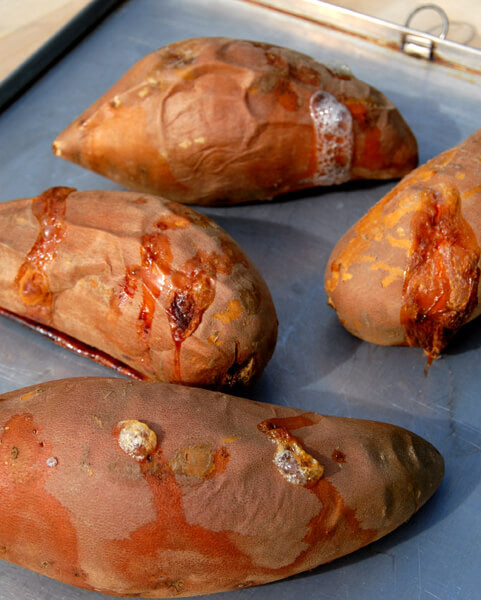Unlike regular potatoes, which grow best when the soil is cool, sweet potatoes like it hot. They are tropical plants that are very sensitive to cold weather. In warm climates, many gardeners plant sweet potatoes about a month after the last spring frost, when both the air and soil are dependably warm. The plants produce lush vines that make a pretty ground cover, so they are a great crop for beds that adjoin areas that are difficult or tiresome to mow.
Begin with vigorous young sweet potato plants from Bonnie Plants®. Because Bonnie has been helping home growers succeed in the garden for over 100 years, you know you'll be starting out strong.
Quick Guide to Growing Sweet Potatoes
- Plant sweet potatoes in warm soil about a month after the last spring frost.
- Space sweet potato plants 12 to 18 inches apart in damp, loamy soil with a pH of 5.8 to 6.2.
- Before planting, improve your native soil by mixing in several inches of aged compost or other rich organic matter.
- Protect young potato plants from weeds by inspecting your garden bed often and gently removing any weeds by hand.
- To maximize your potato growing efforts, keep plants fed with a continuous-release plant food.
- Harvest sweet potatoes when the ends of the vines start to yellow.
- Before cooking, let unwashed sweet potatoes cure in a warm, well-ventilated area for 10 days.
Soil, Planting, and Care
Growing sweet potatoes works best in loamy, well-drained soil. Ideally, the pH should be between 5.8 and 6.2, although they will tolerate a more acidic pH (down to 5.0). Before planting, thoroughly dampen the bed. If your soil is heavy clay, try growing sweet potatoes in raised beds filled with soil designed for that growing environment. Good root development depends on there being plenty of air space in the soil (good aeration). They are the ideal crop for areas with sandy soil. In the North, it's a good idea to cover the soil with black plastic or black fabric mulch about 3 weeks before planting to warm the soil.
Sweet potatoes are so willing to grow that plants accidentally dropped on the ground will take off and grow if the soil they land on is warm and moist. Plant sweet potatoes about 12 to 18 inches apart, and allow 3 feet between rows so the vines will have plenty of room to run. When setting out sweet potatoes in very hot, sunny weather, cover the plants with upturned flower pots for 3 days after planting to shield them from baking sun.
Sweet potato seedlings in containers have a tendency to become root-bound. When the roots — which turn into the actual sweet potatoes — begin to grow in the pot, they will often circle around the inside of the pot. Once that happens, there's a chance they won't fill out properly. To remedy that, before planting, cut each plant off just above the soil line in the container, then plant it (without roots) straight into your garden bed. The slip will form new roots in just 2 to 3 days, and those roots will eventually become fine, well-formed sweet potatoes. Be sure to keep the slips watered well, especially during the first week.
Sweet potato vines will soon cover a large area. Thoroughly weed your sweet potatoes 2 weeks after planting by pulling them gently; if possible avoid deep digging with a hoe or other tool that disturbs the feeder roots that quickly spread throughout the bed. These give rise to your sweet potatoes. Water weekly. Water is especially important as plants grow and roots spread.
Historically, sweet potatoes have been a poor soil crop that produces a decent harvest in imperfect soil, but will do better when planted in good soil and given regular doses of fertilizer. Feed plants with a continuous-release fertilizer that contains potassium (the third number on the fertilizer label), such as Miracle-Gro® Performance Organics® Edibles Plant Nutrition Granules. Gently mix the fertilizer into the soil, following label directions. Then mulch over the soil with an inch of grass clippings or another biodegradable mulch. Continue weeding and adding more mulch for another month. After that, sweet potatoes can usually fend for themselves, though they do benefit from weekly deep watering during serious droughts.
Or, simply feed with a water-soluble plant food, like Miracle-Gro® Performance Organics® Edibles Plant Nutrition every week. Again, be sure to read the label.
Troubleshooting
Deer love to nibble tender sweet potato leaves, so you may need to deter them with floating row covers. Japanese beetles and other leaf-eating insects may cause light damage, but sweet potatoes are so vigorous that they usually outgrow foliage pest problems. More troublesome are pests that might attack the tubers. In Florida and some other Southern states, sweet potato weevils are a big problem, often ruining the harvest. Wireworms and nematodes can also attack sweet potatoes. For advice on how to control these pests, contact your regional Extension agency.
You may have heard of a fungus disease called scurf that is very destructive to sweet potatoes. It is soil-borne and nearly impossible to get rid of once the soil is infested. Fortunately, you can avoid scurf by always planting certified, disease-free plants such as those sold by Bonnie.
In late summer, sweet potatoes often produce flowers that resemble those of morning glory, a close botanical cousin.
Harvest and Storage
Sweet potatoes are usually ready to harvest just as the ends of the vines begin to turn yellow, or just before frost in the North. To avoid injuring tubers, find the primary crown of the plant you want to dig, and then use a digging fork to loosen an 18-inch wide circle around the plant. Pull up the crown and use your hands to gather your sweet potatoes. To make digging easier and get the vines out of your way, you can cut some of them away before digging. Harvest before frost because cool temperatures can reduce the quality of the potatoes and their ability to keep.
Sweet potatoes are not very sweet when first dug, but they are fine for sweetened pies or casseroles. They need a period to sit and "cure" to bring out their sweetness. Shake off soil, and then lay the unwashed sweet potatoes in a warm (80°F to 90°F), well-ventilated place for about 10 days. A shaded table outdoors and out of the rain works well. As the sweet potatoes cure, any scratches in the skins should heal, and the flesh inside will become sweeter and more nutritious. This step is very important, as fresh, uncured potatoes do not bake as well. After 10 days, move your cured tubers to any spot that stays cool and dry, but do not refrigerate or store below 50°F. Cured sweet potatoes will keep for up to 6 months when stored at around 60°F with high humidity; a basement is ideal, though an air-conditioned storage room or pantry will do, too.





FAQs
How long a growing season do I need to raise sweet potatoes?
Sweet potatoes are a tropical vine so they need several months of warm weather. Mulching planting beds with black plastic warms soil - perfect for giving plants a touch of the tropics and reducing weeds. Many of today's varieties are better adapted to growing in shorter seasons than varieties were years ago.
Sweet potato vines are growing beyond the garden area. Can I trim them to keep them in bounds?
The vines of sweet potatoes tend to ramble far and wide, which is why many home gardeners don't raise them. If vines are wandering out of bounds, try turning them back into the vegetable garden. It's best not to trim vines; they help feed the potatoes.
When can I start digging sweet potatoes?
You can harvest sweet potatoes as soon as they reach a usable size, which takes at least three months. Harvest a few tubers to see if they're large enough before digging the entire patch. Plan to dig all sweet potatoes before frost.
How do I harvest sweet potatoes?
Clip vines and save them for the compost pile. Use a garden fork to unearth tubers, starting at the edge of the patch and working your way in toward vines. Sweet potatoes tend to grow near the surface. Dig carefully; tubers bruise easily at this point. Curing is what gives them a hardened skin. If you damage any sweet potatoes during digging, send them straight to the kitchen - they won't cure or store. Use them as soon as possible.
My sweet potatoes are long and thin. Is there something wrong with my soil?
Too much nitrogen in the soil causes long, thin roots. When planting next season, don't improve soil in your sweet potato patch with anything that might add nitrogen (such as compost), and don't fertilize.
Frost is predicted and I haven't harvested all the sweet potatoes. What should I do?
Because sweet potatoes are tropical, frost will harm vines and can also damage roots. If you absolutely cannot harvest all sweet potatoes before frost, mulch the patch heavily with straw or other cover.





 Herbs
Herbs
 Vegetables
Vegetables
 Fruit
Fruit
 Flowers
Flowers
 Succulents
Succulents

